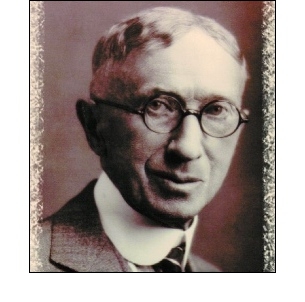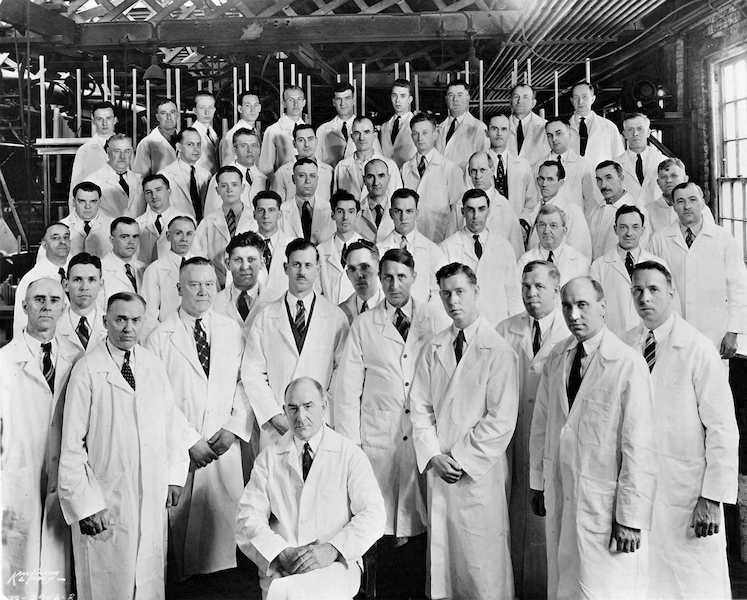From
the The National Cyclopedia of American Biography
Volume 43, pp. 391-392
 DEAGAN, John Calhoun, musician and manufacturer, was born in Hector, N.Y., Nov. 6, 1853, son of Michael and Mary (Meagher) Deagan, both natives of Ireland. He attended public schools in Youngstown, Ohio, and Raines College, and in 1871 enlisted in the U.S. Navy. While his ship, the USS "Brooklyn," was in English waters he studied music at the University of London. A series of lectures in London by Hermann von Helmholtz, German physicist, aroused his interest in the science of sound, and later, while serving musical engagements in various parts of the United States, he conducted experiments which resulted in many contributions to the scope and permanent enrichment of instrumental music.
DEAGAN, John Calhoun, musician and manufacturer, was born in Hector, N.Y., Nov. 6, 1853, son of Michael and Mary (Meagher) Deagan, both natives of Ireland. He attended public schools in Youngstown, Ohio, and Raines College, and in 1871 enlisted in the U.S. Navy. While his ship, the USS "Brooklyn," was in English waters he studied music at the University of London. A series of lectures in London by Hermann von Helmholtz, German physicist, aroused his interest in the science of sound, and later, while serving musical engagements in various parts of the United States, he conducted experiments which resulted in many contributions to the scope and permanent enrichment of instrumental music.
His first product was an improvement upon the crude glockenspiel, which as a German importation had appeared in one or two American orchestras. He succeeded in transforming the rough pieces of metal into a set of perfectly tuned bells which soon became standard orchestra equipment. Deagan began to manufacture these bells in 1880.
Later he developed many other musical instruments, including the xylophone, organ chimes, aluminum chimes, aluminum harp, Swiss handbells, and orchestra bells. The marimba he developed from a novelty from the jungle into an accepted musical instrument. He evolved the original marimbaphone (closed | open) with metal into the vibraharp, the drawn tubular cathedral chime for pipe organ and orchestra use, and the steel bar celeste and wood bar harp for pipe organ use. In 1910 he developed the dinner chime.
Another of his products was a radical improvement in carillons for churches and public buildings, consisting of massive tubular bells, equipped with dampers to eliminate tone intermingling, controlled electrically, and playable both manually from keyboard and automatically from perforated paper rolls, under clock control.
Beginning in 1898 he gave his entire time to the manufacture of the instruments he had invented. Starting as a one-man operation in St. Louis, Mo., he moved to San Francisco, Calif., and finally to Chicago, Ill. The business was incorporated in 1913 as J. C. Deagan Musical Bells, Inc. Three years later the name was changed to J. C. Deagan, Inc. He was president of the corporation from its inception until the close of his life.
In 1910 Deagan persuaded the American Federation of Musicians, at its annual convention, to adopt A-440 as the standard universal pitch for orchestras and bands, thus settling a question which had long agitated musical circles. It was also accepted by the United States government and generally throughout the world. In 1914, at the request of the U.S. Bureau of Standards, he supplied it with a set of tuning forks, for radio research and other purposes, giving accurate pitch intervals from 100 to 2000 vibrations per second. A year later he perfected the so-called Deagan-o-meter, a device for demonstrating musical pitch simultaneously both by ear and eye.
Another important part of his work on pitch was the compilation in 1915 of a musical chart which has been used by musicians and teachers of music throughout the world. A much more extensive work of the same kind was nearing completion at the time of his death and was posthumously published.
He was the author of numerous articles for musical journals. For some years he belonged to the board of curators of the Field Museum in Chicago. Deagan was a charter member of the American Federation of Musicians and a member of the American Association for the Advancement of Science, American Physical Society, American Acoustical Society, Astronomical Society of the Pacific, and the J. C. Deagan Astronomical Society (named in his honor), of Riverside, Calif.
He was deeply interested in astronomy, geology, chemistry, and all branches of physics, particularly the theories of light and sound, and he was considered an authority on pitch and acoustics. In his leisure time he read widely and enjoyed travelling to many parts of the world. Politically he was an independent.
Deagan was married in Belleville, Ill., Nov. 20, 1884, to Sophia Katherine, daughter of Frederick Funcke of that place, a cabinet-maker, and had four children: Jefferson Claude; Frederick Waldo; Michael Roy (died in infancy); and Marion Vita, who married Richard Joseph Welch. Deagan died in Hermosa Beach, Calif., Apr. 28, 1934.


